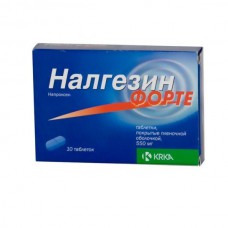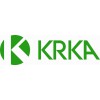Expiration date: 06/2026
The composition and form of issue:
Tablets, film-coated. 1 tablet contains:
naproxen sodium 550 mg
excipients: microcrystalline povidone talc magnesium stearate purified water
shell: dye Opadry YS-1-4215 (ready mix titanium dioxide (E171), macrogol, the dye Indigo Carmine (E132) and these)
in blister 10 PCs. in a pack of cardboard 1 blister.
Description of dosage form:
Oval biconvex tablets scored on one side, film-coated blue.
Pharmacokinetics:
Absorption from the gastrointestinal tract is rapid and complete bioavailability of 95% (eating virtually no effect on the completeness nor on the rate of absorption). Tmax is 1-2 hours, the connection with plasma proteins >99%, T1/2 is 12-15 hrs Metabolism in the liver to dimetilsiloksana with the participation of the CYP2C9 enzyme system. Clearance — 0, 13 ml/min/kg. Appears on 98% of kidneys (10% in unaltered), with bile — 0, 5-2, 5%. Css is determined to take 4-5 doses of the drug (2-3 days). In renal insufficiency, the accumulation of metabolites is possible.
Description of the pharmacological action:
The mechanism of action is associated with non-selective inhibition of the activity of COX-1 and COX-2.
The tablets covered with a film cover, Nalgezin Forte dissolve well, are quickly absorbed from the gastrointestinal tract and provide a rapid onset of analgesic effect.
Indications:
- diseases of the musculoskeletal system (rheumatoid arthritis, psoriatic, juvenile chronic arthritis, ankylosing spondyloarthritis (Bekhterev's disease), gout arthritis, rheumatic soft tissue damage, osteoarthritis of the peripheral joints and spine, including with radicular syndrome, tendovaginitis, bursitis)
- pain syndrome weak or moderate intensity: neuralgia, ossalgia, myalgia, sciatica, post-traumatic pain (sprains and bruises), accompanied by inflammation, postoperative pain (in traumatology, orthopedics, gynecology, oral and maxillofacial surgery), headache, migraine, algomenorrhea, adnexitis, toothache
- as part of the complex therapy of infectious and inflammatory diseases of the ear, throat, nose with severe pain syndrome (pharyngitis, tonsillitis, otitis)
- feverish syndrome at catarrhal and infectious diseases.
Nalgesin Forte is used for symptomatic therapy (to reduce pain, inflammation and reduce elevated body temperature) and the progression of the underlying disease does not affect.
Contraindications:
- hypersensitivity to naproxen or naproxen sodium with anamnestic data about the attack of bronchial mast, rhinitis, urticaria after taking acetylsalicylic acid or other NSAIDs (complete or partial syndrome of intolerances acetylsalicylic acid — rhinosinusitis, urticaria, polyps are nasal mucosa, bronchial asthma)
- period after coronary artery bypass grafting
- erosive-ulcerative changes in the mucous membrane of the stomach or duodenum, active gastrointestinal bleeding
- inflammatory bowel diseases in the acute phase (ulcerative colitis, Crohn's Disease)
- cerebrovascular bleeding or other bleeding and hemostatic disorders
- severe hepatic impairment or active liver disease
- expressed kidney failure (Cl creatinine less than 20 ml/min), including confirmed hyperkalemia, progressive disease of the kidney
- oppression kostnomozgovy blood
- pregnancy, breastfeeding
- one pill Nalgezin Forte contains 550 mg naproxene, so the drug is not recommended for children and adolescents under 15 years.
Caution: IHD, cerebrovascular disease, congestive heart failure, dyslipidemia/hyperlipidemia, diabetes mellitus, peripheral artery disease, Smoking, and Cl creatinine less than 60 ml/min anamnestic data about the development of ulcerative shock syndrome, infection of Helicobacter pylori, older age, prolonged use of NSAIDs, frequent use of alcohol, serious somatic diseases, concomitant therapy with the following drugs: anticoagulants (e.g. warfarin), antiplatelet agents (e.g. acetylsalicylic acid, clopidogrel ), oral GC (e.g., prednisone), SSRIs (e.g. citalopram, fluoxetine, paroxetine, sertraline). To reduce the risk of adverse events from the digestive tract should use the minimum effective dose of the minimum possible rate. Children under 15 years of age the drug is prescribed only on the recommendation of a doctor.
Application during pregnancy and breast-feeding:
Nalgesin Forte is not recommended during pregnancy and lactation.
Side effect:
Side effects are most common when using high doses of the drug Nalgesin Forte.
From the digestive system: constipation, abdominal pain, dyspepsia, nausea, diarrhea, ulcerative stomatitis, erosive ulcerative lesions and bleeding gastrointestinal tract, increased activity of liver enzymes, impaired liver function, jaundice, bloody vomiting, melon.
From the Central nervous system: hearing loss, dizziness, headache, drowsiness, depression, sleep disorders, inability to concentrate, insomnia, malaise, myalgia and muscle weakness, slowing the reaction rate, aseptic meningitis, cognitive dysfunction.
From the skin: itching, ecchymosis, increased sweating, purple, alopecia, photodermatosis.
From the sensory organs: tinnitus, impaired vision, impaired hearing.
From the cardiovascular system: swelling, shortness of breath, palpitations, congestive heart failure, vasculitis.
With the genitourinary system: glomerulonephritis, hematuria, interstitial nephritis, nephrotic syndrome, renal failure, renal papillary necrosis, disturbances of the menstrual cycle.
From the blood-forming organs: eosinophilia, granulocytopenia, leukopenia, thrombocytopenia, aplastic anemia.
The respiratory system: eosinophilic pnevmonity.
Allergic reactions: skin rash, urticaria, angioedema, epidermal necrolysis, erythema multiforme, Stevens-Johnson syndrome.
Others: thirst, hyperthermia, hyperglycemia, hypoglycemia, increase in bleeding time, hemolytic anemia.
In case of such phenomena should stop taking the drug and, if possible, consult a doctor.
Drug interaction:
In the treatment of anticoagulants should be borne in mind that naproxen may increase the bleeding time. You should not use this medication simultaneously with other NSAIDs (increased risk of side effects development).
Patients simultaneously receiving hydantoins, anticoagulants or other drugs that bind strongly to plasma proteins, should monitored for signs of potentiation of or overdose of these drugs.
The drug Nalgezin Forte can reduce the antihypertensive effect of propranolol and other beta-blockers, and can also increase the risk of renal failure associated with the use of ACE inhibitors. Under the action of naproxen is inhibited natriuretic effect of furosemide. Inhibition of renal clearance of lithium leads to an increase in lithium concentrations in plasma. Probenecid intake increases the level of naproxen in plasma. Cyclosporine increases the risk of developing kidney failure.
Naproxen slows down the excretion of methotrexate, phenytoin, sulfonamides, increasing the risk of developing their toxic effects.
Antacids containing magnesium and aluminium reduce absorption of naproxen.
If the patient has any other diseases or allergies, or when taking any other drugs, it is necessary to inform the healing doctor.
Method of application and doses:
Inside. You should strictly follow the doctor's instructions, do not stop treatment and do not change the dosage without consulting your doctor in advance.
The usual daily dose used for pain relief is 1-2 tables. (550-1100 mg).
With very severe pain and lack of history of gastrointestinal diseases, it is possible to increase the daily dose to 3 tables. (1650 mg), but not more than 2 weeks. When using the drug as a means of ingesting the initial dose is 1 tab. (550 mg) was then taken at 0, 5 tab. (275 mg) every 6-8 hours
For the prevention of migraine attacks recommended 1 table. (550 mg) twice a day. However, treatment should be stopped if the frequency, intensity and duration of migraine attacks do not decrease within 4-6 weeks. At the first sign of migraine attack should take 1 5 tablets (825 mg), and if necessary even to 0, see table 5-1. (275-550 mg) after 30 min.
To relieve menstrual pain and cramps, pain after the administration of the IUD (intrauterine spirals) and other gynecological pain (adnexitis, childbirth as an analgesic and tocolytic agent), it is recommended to prescribe the drug in the initial dose of 1 table. (550 mg), followed by 0, 5 tab. (275 mg) every 6-8 hours
In an acute attack of gout initial dose is 1, 5 table. (825 mg), hereinafter 1 table. (550 mg) after 8 h, and then 0, 5 table. (275 mg) every 8 h until termination of the attack.
In rheumatoid diseases (rheumatoid arthritis, osteoarthritis and ankylosing spondylitis), the usual initial dose of the drug is 1-2 tables. (550-1100 mg), twice a day, morning and evening. The initial daily dose of 1, 5 (825 mg) -3 table. (1650mg) is recommended for patients with severe nocturnal pain and/or severe morning stiffness, patients transferred for treatment with naproxene sodium from high doses of other NSAIDs, and patients with pain as the leading symptom. Usually the daily dose is 1 table. (550 mg) - 2 tables. (1100 mg) that is assigned in two steps.
Morning and evening doses may not be the same. With the consent of the attending physician, they can be changed depending on the prevalence of symptoms, i.e. night pain and/or morning stiffness.
If it seems that the effect of the drug is very strong or weak, you should inform the attending physician or pharmacist.
Overdose:
Symptoms: drowsiness, dyspeptic disorders (heartburn, nausea and vomiting, abdominal pain), weakness, tinnitus, irritability in severe cases — bloody vomiting, melena, impaired consciousness, convulsions and renal failure.
Treatment: gastric lavage and symptomatic therapy — activated charcoal, antacids, H2 receptor blockers, proton pump inhibitors. Hemodialysis is ineffective.
Special instruction:
It is not recommended to exceed the doses specified in the instructions. To reduce the risk of adverse events from the digestive tract should use the minimum effective dose of the minimum possible short course.
If pain and fever persist or become stronger, you should consult a doctor.
Patients with bronchial asthma, blood clotting disorders, as well as patients with hypersensitivity to other analgesics should consult a doctor before taking Nalgesin Forte.
Caution should be prescribed to patients with liver disease and renal insufficiency. In patients with renal insufficiency it is necessary to monitor the level of creatinine clearance. At the level of creatinine CL below 20 ml/min, it is not recommended to prescribe naproxen. In chronic alcoholic and other forms of cirrhosis, the concentration of unrelated naproxene increases, so these patients are recommended lower doses.
Nalgesin Forte should not be taken with other anti-inflammatory and painkillers, except as directed by a physician.
Older patients are also recommended lower doses.
Should avoid taking naproxen for 48 hours before surgery. If it is necessary to determine 17-corticosteroids, the drug should be canceled 48 hours before the study. Similarly, naproxen may influence the determination of 5-hydroxyindoleacetic acid in urine.
The use of naproxen, as well as other drugs that block the synthesis of PG, can affect fertility, so it is not recommended for women who want to get pregnant.
Each nalgesin Forte tablet contains approximately 50 mg of sodium. This should be taken into account when limiting salt consumption.
Influence on the ability to drive a car and other mechanisms: naproxen slows down the rate of reaction in patients. This should be taken into account when driving and performing tasks requiring increased attention.



